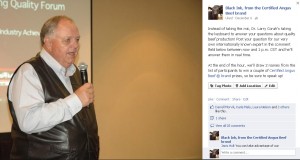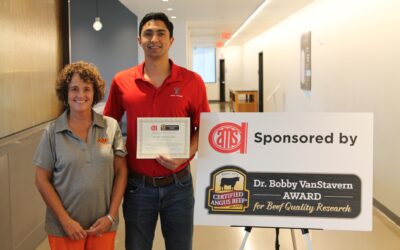
Wrapping up Dr. Corah live – Part II
Today, we wrap up. Here’s Part II:

Question: We’re trying to raise bulls that help cow-calf customers target the CAB brand. Are there any minimum marbling EPD thresholds that we use as seedstock producers?
Answer: There are not any minimum requirements but two things are especially important in the amount of marbling that will ultimately be present in the progeny resulting from using your bulls. The first is the actual marbling EPD and because marbling is so highly heritable the higher the marbling EPD the higher the probability the calf will qualify for the Certified Angus Beef program. The second that is really important is that the cow side also carries genetics for marbling potential and by stacking the genetics on both the cow and bull sides, we have seen tremendous CAB acceptance rates, often adding dollars to the pocket of the producer.
Question: In regards to hitting the CAB target of marbling…we have often heard the phrase, “Never let them have a bad day.” What impact does slowing weaned calves down (to around 1 pound average daily gain) in an over-wintering program awaiting spring grass have on their future potential to hit the CAB marbling target? And, is 1 pound of gain for a few months “having a bad day”?
Answer: As we learn more about how the production system impacts marbling, we are learning that we’ve got some flexibility in the stocker (grower) phase in how we develop cattle and whether they’ll qualify for the CAB brand. That research data is showing the cattle that gain about 1 pound a day during the growing period can still reach high CAB acceptance rates if they are properly finished during the feedlot phase. By properly finished we are referring to hitting a compositional endpoint of .5 to .6 inches of fat cover, and if that is achieved, generally the probability of hitting the high-quality target is still successful.
Question: What would you suggest to someone who is considering getting into the cattle business and wants to provide quality and not just quantity?
Answer: The 2 most important profit drivers on cattle sold on the grid are quality grade and weight. What needs to be the goal of cattle producers is they produce pounds but those pounds are of a high-quality product that creates a positive eating experience for the consumer. That is absolutely critical at the price we are selling beef for today and with the input costs that we have to produce product, we have to sell at higher prices.
Weren’t those some great questions? Next time we do a live chat, we hope you’ll join us!
You may also like
Purpose Follows Passion
A chance opportunity. A change in career direction. And meat science was changed forever. Dr. Gary Smith originally had no plans to become a meat scientist. But thank goodness he did.
Marbling, Feet and Fertility: Are they related?
The Angus breed has enough genetic diversity to allow breeders, and their commercial bull customers, to make progress across multiple traits simultaneously. One bloodline may be high in marbling but does not check the boxes you need for other traits. That does not mean marbling is the cause—it simply means your search for the ideal genetic pairing is not done.
Certified Angus Beef Recognizes Beef Quality Research
First-place honors go to Andres Mendizabal, an international student pursuing a Ph.D. in animal science at Texas Tech University. His research is titled, “The Accuracy of USDA Yield Grade and Beef Carcass Components as Predictors of Red Meat Yield.”



